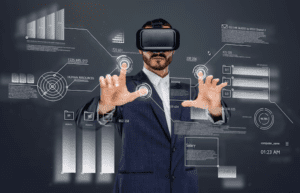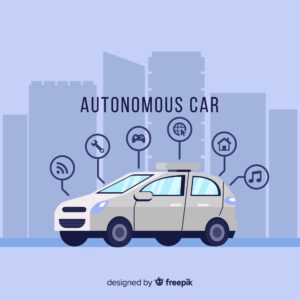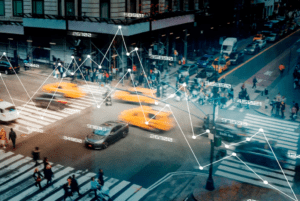Real-time computer vision technology enables instant processing and analysis of visual data, allowing for applications in areas such as security, self-driving vehicles, and healthcare.
Computer vision is an emerging computer science and engineering topic that draws heavily from many other areas. Researchers’ focus is shifting towards creating vision algorithms that can perform real-time analysis of dynamic images. Automated systems need real-time vision to keep up with and effectively control or react to real-world activity. The advent of autonomous vehicle manufacturing completely rocked the 21st-century car industry. This post will describe the effect of AI in the automobile industry.
What is Real-time Computer Vision?

Image credit: https://claudeai.uk/
Real-time computer vision refers to the ability of a computer system to process visual data in real-time, which means that the system can process images and video as they are captured without significant delay. This capability is essential for autonomous systems, as they must react to changes in their environment in real-time.
Real-time Computer Vision in Autonomous Systems
Using computer vision to improve car safety might be a game-changer for the auto industry. The ability of robots to recognize objects and make predicted decisions allows them to save countless lives and valuables every day. The use of computers for visual purposes in cars dates back to the 1960s. Institutions devoted to studying artificial intelligence have been at the cutting edge of computer vision development since its inception in 1966. The original aim of these early computer vision systems was to function similarly to the human visual system. Computer vision systems were also differentiated from the then-dominant discipline of digital image processing by the need to extract 3D structures from pictures for complete scene interpretation. There has been a recent boom of technical innovation in the transportation industry, with computer vision at the forefront of this development. Autonomous cars and parking occupancy detection are just two examples of how the Intelligent Transportation System (ITS) is helping to revolutionize the transportation industry. We will now discuss a few uses of computer vision that are contributing to the development of autonomous cars that are both safer and more dependable.
Self-driving cars
By 2023, autonomous vehicles will have become a reality rather than just a science-fiction concept. A large number of engineers and developers all around the world are busy testing and improving the reliability and safety of autonomous vehicles. 
Computer vision recognizes and sorts things like traffic signals and road signage. It’s also used for things like 3D mapping and motion estimation, playing a significant role in making autonomous cars a reality. Sensors and cameras in autonomous vehicles collect data about their surroundings, which the cars then use to make decisions and take action.
Computer vision techniques, including pattern recognition, object tracking, feature extraction, and 3D vision, are used by researchers developing ADAS technology to construct real-time algorithms that assist in driving operations.
Pedestrian detection
Researchers in computer vision have found that automating the identification and monitoring of pedestrians using cameras is crucial. This is because of its potential usefulness in advancing intelligent city technology and pedestrian safety measures. Cameras collect images or videos of pedestrians. The procedure entails detecting and pinpointing these individuals despite confounding variables such as clothing and body position, occlusion, changes in lighting, and background noise. Detecting pedestrians has several real-world applications, including improving autonomous driving, traffic management, and public transit security and efficiency.
Parking occupancy detection
When monitoring parking lot occupancy, computer vision-based Parking Guidance, and Information (PGI) systems provide a low-cost, low-maintenance alternative to more traditional sensor-based methods. Camera-based parking occupancy detection systems that use Convolutional Neural Networks (CNNs) have reached a new level of accuracy, maintaining dependability despite changes in weather and lighting. Integrating Licence Plate Recognition with parking occupancy monitoring enables real-time tracking of which vehicles are parked where. In addition, below are additional datasets that may be used to train parking lot identification algorithms.
- PKLot
- CNRPark-EXT
Traffic flow analysis

Because of recent developments in computer vision, tools like drones and cameras may now be used to estimate and monitor traffic patterns. The algorithms available today can accurately identify and count cars on highways and evaluate traffic density at urban locations like junctions. This skill facilitates the development of better traffic management systems and enhances traveler security.
Road condition monitoring
The field of computer vision has also yielded fruitful results in the domain of defect detection, with concrete and asphalt conditions being evaluated by analyzing changes in the infrastructure. Automated pavement distress detection has successfully enhanced road maintenance resource allocation efficiency and reduced the risk of accidents.
Computer vision algorithms employ the data captured by image sensors to develop automated systems for detecting and categorizing cracks. These systems facilitate targeted maintenance and preventive measures, freeing humans from the need for manual inspection.
Stereo vision
Accurate depth estimation is crucial for ensuring passengers’ and vehicles’ safety. While tools like LIDAR and camera radar are integral to this process, stereo vision provides an additional backup layer.
However, this approach presents various challenges. For instance, each vehicle’s camera arrangement can differ, making depth estimation more complicated. The distance between camera lenses also affects accuracy, with longer distances providing more precise estimates but introducing perspective distortion.
Moreover, self-driving vehicle cameras may capture dissimilar images, lacking a pixel-to-pixel world representation, leading to the issue of unparalleled representation. The varying representation of images captured by self-driving vehicle cameras makes it challenging to calculate distances accurately. Even a tiny hardware shift in a pixel can significantly alter the image’s representation, further complicating the calculation process.
Conclusion
The development of self-driving cars has brought forth a vast array of discoveries and technological advancements in artificial intelligence. However, this progress was only possible with advanced datasets and reliable computer vision algorithms. The development of autonomous cars will rely heavily on AI and computer vision in the near future. Standard practices include the use of pattern recognition and learning methods for identifying puzzling patterns. Incorporating computer vision algorithms into car manufacturers’ planning and creating cutting-edge techniques for producing the five levels of autonomous vehicles is a significant step forward. As a result, the workforce in this area must continue to expand to meet the growing demands and address the challenges faced in developing increasingly accurate and efficient models.






